Precarity is that here and now in which pasts may not lead to futures. – A.L. Tsing
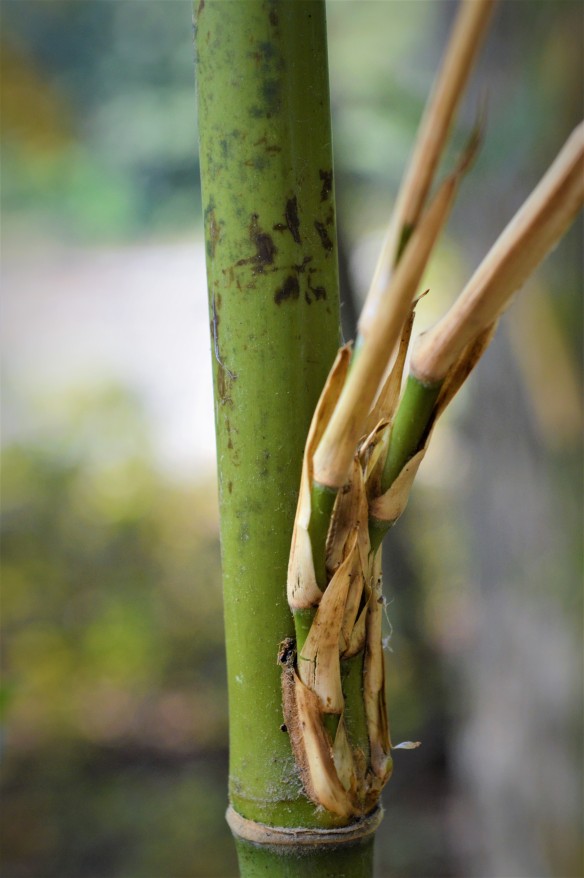
River cane. You can tell it apart from bamboo, which it otherwise resembles, by it’s smaller maximum stem diameter (if you see plants with greater than 3 inch stems, probably bamboo) and this little sulcus (groove) on the stem above the node. If you find it, keep it safe!
Anna Tsing’s 2015 book “The Mushroom at the End of the World: On the Possibility of Life in the Capitalist Ruins” explores how places that are seen as ecological travesties, such as lodgepole pine plantations in Oregon, have become habitat for a species with enormous economic value: the matsutake mushroom. This mushroom underpins an informal economy that, among other things, provides an escape from wage labor to Southeast Asian refugees and American Vietnam vets alike. Looking deeper back in time, the matsutake has always been associated with early-growth forests and human disturbance. In Japan, where this ‘weedy’ mushroom is most valuable and meaningful, urbanization and conservation have reduced the extent of this kind of heavily disturbed forest habitat. Now Japanese demand is met by pickers in America’s plantation forests.
Last Thursday, I was driving through a section of the Big Creek Wildlife Management Area in central Arkansas with my friend Liz Horton. I was trying to find places where the dirt roads crossed creeks and rivers, because these are the best places to look for the plant species I am studying. On our first attempt to penetrate this publicly owned space, which ostensibly exists to provide habitat for wildlife and hunting and fishing for the citizens of Arkansas, we immediately encountered a metal gate plastered with disconcerting signs. “Biocontainment area,” they cryptically warned. “Keep gate closed and locked” – although it stood open. Proceeding cautiously onward, we found ourselves in the middle of fracking station. There are hundreds of these stations on publicly owned land in north-central Arkansas. They have been accused of everything from illegally injecting diesel fuel into the ground water to increasing the incidence of earthquakes (in nearby Oklahoma).
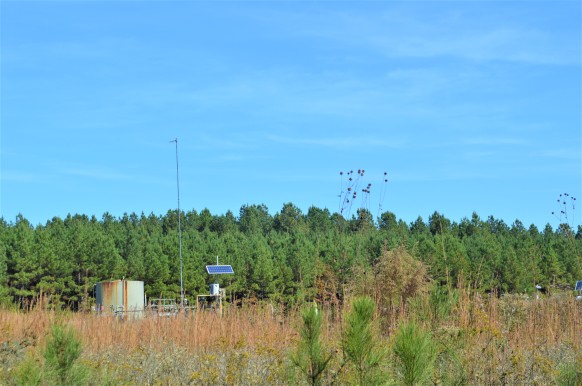
Photo of fracking station in timber plantation, Arkansas, that I surreptitiously took while creeping by at 2 miles per hour.
This experience echoed my exploration, weeks of earlier, of Wayne National Forest in Appalachian Ohio, where fracking and conventional oil drilling operations are leasing large parts of federally owned conservation areas, transforming these spaces from a refuge for the people, plants, and animals who live there to a liability and health hazard. These are only the latest in hundreds of years of irresponsible, but entirely legal, extractive industries in this forest, beginning with clear cutting by Euroamerican settlers, which eliminated all of the old growth forests in the eastern United States except for a few tiny pockets. In the Wayne, we saw rivers running red with old mining effluent. Acid seeps out of old coal piles and abandoned mines, eliminating all aquatic life in many streams. Both of these “natural areas” are surrounded by poor communities who bear disproportionate health and environmental costs.
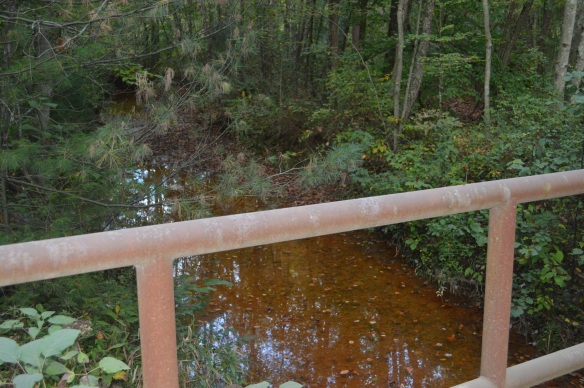
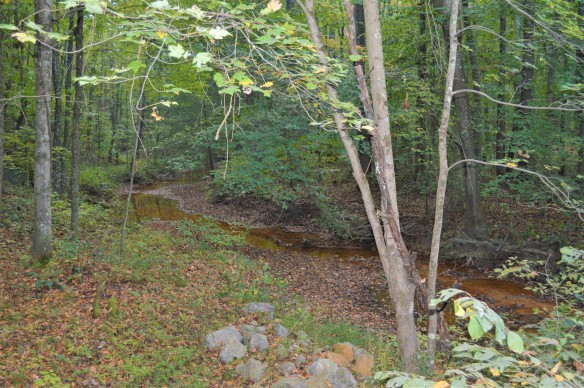
Monday Creek in Wayne National Forest runs red from old mining effluent
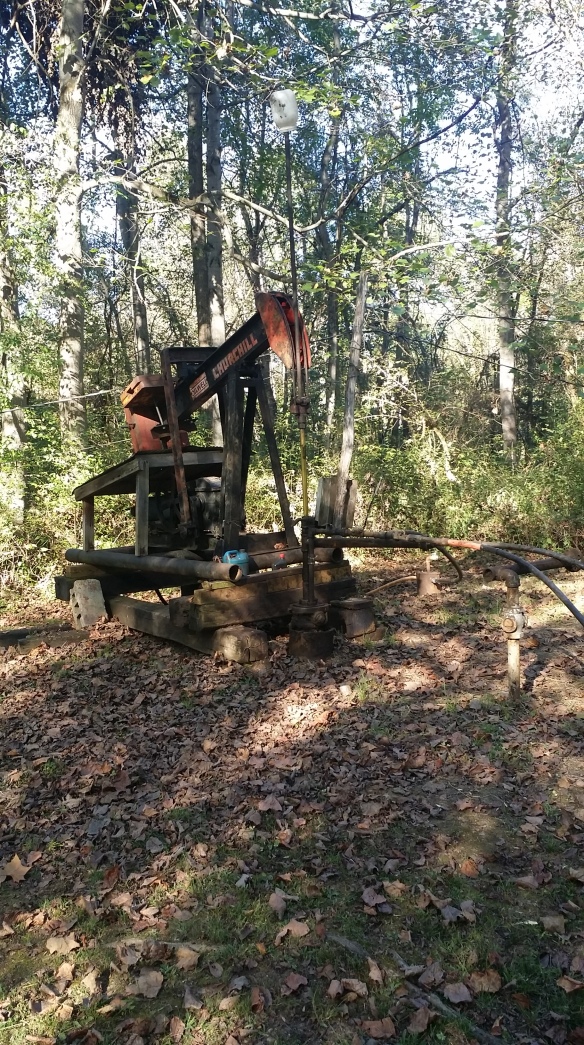
Conventional oil well in Wayne, near the Ohio River. I saw dozens of these over the course of two days, some surrounded by splatters of oil and dead plants, others inhabiting seemingly healthy clearings.
But sometimes in the most ravaged places, I find the rare native plants I am looking for, as when we found a population of marsh elder growing in an old pit mine. In these places, the presence of lost crops provides a glimmering of the deep history of this land and its entanglement with people – a reminder of another way of inhabiting this landscape that was based on enhancement rather than extraction. These plants survive where they do because of their ancient affinity with people, what you might call weediness, and despite an array of institutions that are indifferent to their annihilation. It is important to keep in mind that although some fragments of native plant and animal communities remain, the Indigenous communities who tended and carefully managed these ecosystems for thousands of years were long ago forced off of the lands that I study, which are now being somewhat less thoughtfully managed by the US government and various industries.
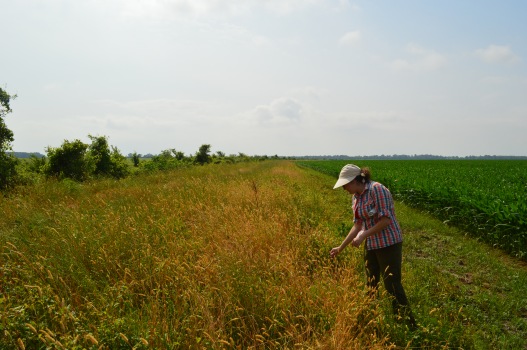
Maygrass growing alongside GM herbicide tolerant maize field, Arkansas, 2015.
In May of 2015, my colleagues and I found an enormous stand of maygrass, another lost crop, growing alongside a corn field in southeastern Arkansas. This weedy margin was probably saved by the fact that it was growing right alongside a “ditch” – an old bayou that has been canalized by the building of levees – and was separated from the corn field by a dirt road. This small separation was key. We could tell by looking at the eerie cleanliness of the corn field that it was glyphosate resistant maize (like almost 90% of the maize grown in the US), a genetically modified crop that can withstand being sprayed with herbicide (“Round up ready”). We’d been looking for maygrass on field margins devoid of any living plants for three days before we found this remnant. The advent of GM herbicide resistant crops has spelled doom for ecosystems of weedy annual plants that once thrived in agricultural landscapes.
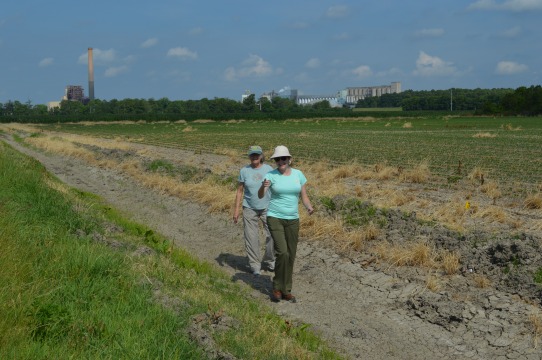
Shrinking margins in GM herbicide tolerant soy fields, Mississippi, 2015.
The situation for rural wild flowers and weeds was already bad two years ago, but it just took a turn for the apocalyptic. During the twenty years since the release of glyphosate tolerant crops, glyphosate has killed many weeds – but not all. The survivors have rapidly evolved the same herbicide tolerance that was engineered into the crops. One plant in particular has come to plague farmers: palmer amaranth. Maybe you’ve heard of amaranth – it’s a common weed (sometimes called pigweed) with edible leaves best enjoyed as a vegetable in the spring. It’s also a grain crop in Mexico and the US southwest, and one of the lost crops of eastern North America – it was grown as a crop in Arkansas for at least 600 years by Indigenous people. But now, after 20 years of GM crops and wanton glyphosate spraying, it has a new role to play as a superweed. It is impossible to kill and extremely invasive. I don’t think I was out of sight of a palmer amaranth plant the entire time I was in the state of Arkansas. So in 2016, Monsanto and BASF rolled out a solution: a new generation of herbicide tolerant cotton and soy that were designed to work with a new herbicide called dicamba – a chemical savior that could slay the superweeds.
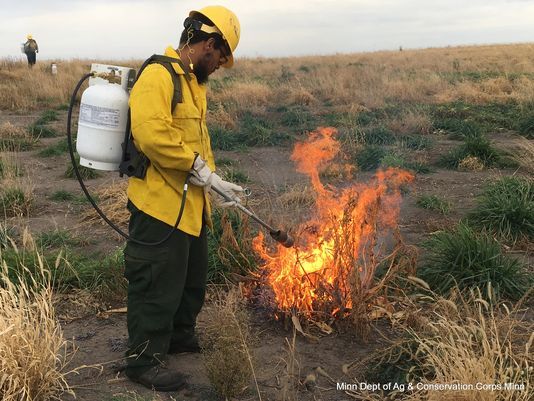
Blow torching palmer amaranth in Minnesota, 2016
This summer, the use of the new genetically modified crops increased dramatically, and so did dicamba spraying. This strategy did kill some superweeds – but it also led to millions of acres of damaged crops and untold damage to wild ecosystems, which were already surviving at the margins. The problem is that dicamba is much more volatile than glyphosate. It floats up off of the dirt and drifts around when it’s hot and humid (probably didn’t help that 2017 was the 2nd hottest year on record). So farmers who made the switch had a great year – their neighbors who didn’t plant dicamba resistant crops were not so lucky. If this situation continues, cotton and soy farmers will have no choice but to adopt the new tech, meanwhile farmers who grow other crops for which dicamba resistant seeds are not available (not to mention anyone who still cares about wild plants) have no choice but the suffer the consequences of yet another irresponsible, destructive industrial method for extracting profit.
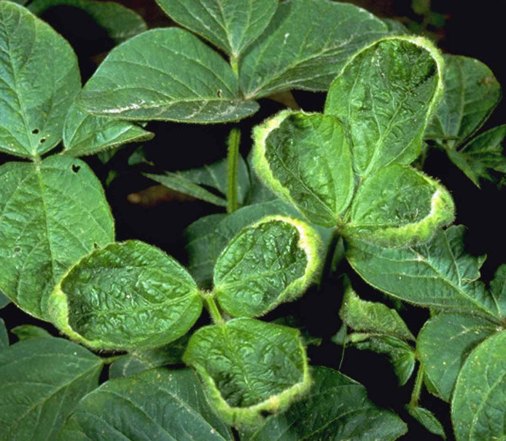
Soybean with dicamba drift damage. Photo: Univerity of Arkansas Cooperative Extension Service
Last Friday, as I was driving back north towards Missouri, a curious piece of news broke. Monsanto announced that it is suing the Arkansas State Plant Board, which is trying to stop this egregious state of affairs by prohibiting dicamba use in hot weather. Yes. You read the right. Millions of acres of crops were damaged by their new product and they’re suing Arkansas for trying to put limits on its future use.
Anyway. Back in Big Creek WMA, we backtracked quickly and quietly out of the fracking station and tried another route. We soon found ourselves driving through a vast timber plantation. This homogenous pine forest is created by plowing deep furrows and machine planting identical pine seedlings at regular intervals. When the trees reach a prescribed age, the area is clear cut, any remaining undergrowth is burned, and the process begins again. Much like other forms of industrial agriculture, this creates an extremely simplified ecosystem whose purpose is to maximize growth of a single commodity species. Among other problems, clear cutting leads to erosion of hillsides, which can clog streams and cause more severe and destructive flooding.
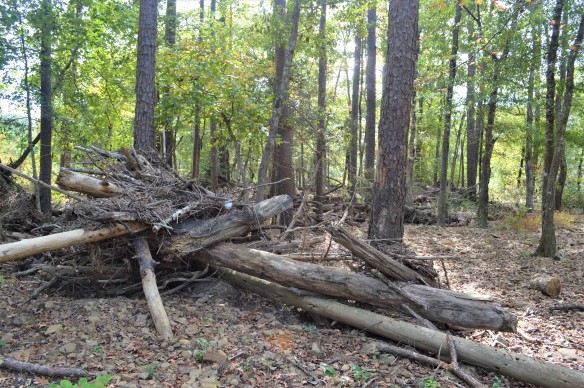
Flood debris
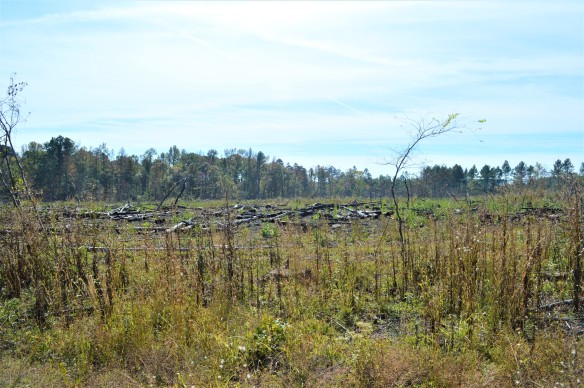
Clear cut area
In a pocket of valley too steep for industrial tree-farming, we stumbled upon something Liz had been trying to show me for years: a big stand of native river cane. Cane brakes used to cover vast swaths of the river valleys of eastern North America. It was extremely important to the livelihoods of Indigenous communities, who used it for baskets, combs, gaming pieces, drills, pipes, arrow and dart shafts, blowguns, tattoo needles, and more. It is still needed for some of these uses, especially to make beautiful cane baskets, by Indigenous Southeasterners, but it is in increasingly short supply.
River cane is now considered critically endangered, which made finding it on the margin of this industrial landscape all the more jarring. While I tend to focus on food (in my research as well as my personal life), I think Liz is quite correct when she insists that fiber crops were just as important to ancient people as food crops. Among these, river cane was undoubtedly one of the most important, but little is known about how it was managed and tended. Its once-abundance lives on in dozens of cane-related place names across the southeast and Midwest.
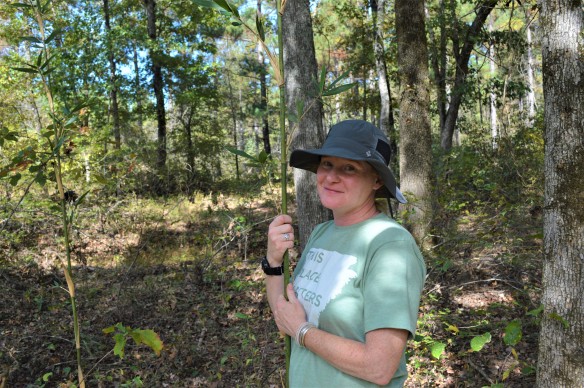
Dr. Liz Horton, happy to have found one of her favorite plants.
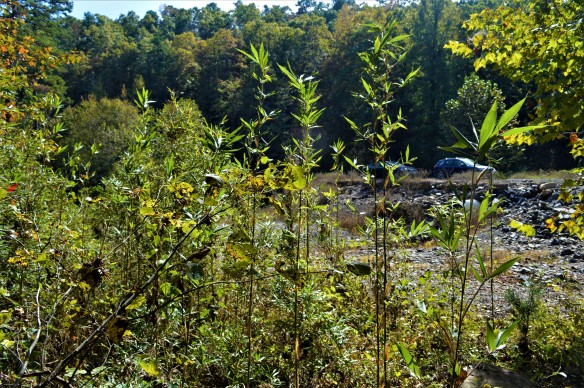
Stand of cane. The creek valley in the background is full of recent run-off from the industrial timber farm upstream.
I’m not sure how to conclude these observations. I don’t know what surprises me more: the unheeding destructiveness of many of the rural industries I encountered, or the fact that anything other than commodity crops manages to survive among them. I suppose it is as Hollywood chaotician- Jeff Goldbaum said, “Life finds a way.”


I believe there’s a fairly large stand of river cane on the north side of Route 66 between Troy and Tell City, IN. We had a little stand of it where I grew up not too far away and it looks the same, anyway.
LikeLike
Monsanto is evil and must be destroyed. As you know, there are many people working on this. In the meantime, for those with a more positive bent it is more important than ever to follow the advice of the Principia Discordia: Plant your seeds!
LikeLike
Hi, Natalie. Great blog.. Fascinating subject. Just a nit pick. You can’t distinguish river cane from bamboo, because it is a bamboo with lovely genus name: Arundinaria Of course I could be wrong. They change these classifications all the time.
LikeLike
Haha! That’ll teach me to mix Latin names and common names. I’m not an expert on bamboo, but my understanding is that “bamboo” can be used to refer to the entire subfamily Bambusoideae, and Arundaria is one of dozens of genera in that subfamily. Arundaria has also been debated over the years as you say. I believe it is currently circumscribed to include only the three North American species, but as you say these things change all the time and there have been descriptions that also put species from Asia in there. I don’t know anywhere near enough about it to have an opinion about which group is better supported! I meant to distinguish between the native species and invasive bamboos that came in as garden plants. I’m not sure what species the most common invasive bamboos are, but a quick google search suggests maybe this guy https://www.invasivespeciesinfo.gov/plants/goldenbamboo_child.shtml.
LikeLike